Wintertime Cross-Correlational Structures Between Sea Surface Temperature Anomaly and Atmospheric-and-Oceanic Fields in the East/Japan Sea Under Arctic Oscillation
Abstract
1. Introduction
2. Materials and Methods
2.1. Data
2.1.1. Sea Surface Temperature (SST)
2.1.2. Atmospheric and Air–Sea-Coupled Variables (ERA5)
2.1.3. Oceanic Variables
2.1.4. Arctic Oscillation (AO) and Phase Selection
2.2. Methodology
2.2.1. Detrended Cross-Correlation Analysis (DCCA)
2.2.2. Monte Carlo Significance and Quality Control for and
2.2.3. False Discovery Rate (FDR) Control Across Space and Scale
- (1)
- For , for each fixed scale , the family comprises all cells’ p-values .
- (2)
- For , there is one statistic per cell, so the family is over all cells.
2.2.4. Implementation Details and Robustness
3. Analysis Results
3.1. SSTA Variability and Persistence: AO–Phase Contrasts
3.2. Local Coupling with Atmospheric Fields
3.3. Local Coupling with Coupled Heat-Flux Anomalies
3.4. Local Coupling with Oceanic Fields
4. Discussion
4.1. Synthesis of the Main Findings
- SSTA variance and persistence () concentrate along the EKB and the SPF during AO+, with 1.4–1.5 (Figure 1), indicating strong long-memory behavior in the daily anomaly field and, by implication, elevated susceptibility to persistent warm events in those corridors.
- Among atmospheric drivers, near-surface air temperature (ATMPA) exhibits basin-wide positive, scale-averaged (5–50 days) and localized cross-persistence , whereas sea-level pressure and wind-stress curl produce patchy and rarely yield robust (Figure 2, Figure 3 and Figure 4). Zonal (UA10) and meridional (VA10) winds display physically consistent signs—mostly negative and positive , respectively—with that is sparse or confined to advective corridors.
- SSHF and SLHF act as fast, negative feedbacks: is widespread and is virtually absent.
4.2. Physical Interpretation and AO Modulation
4.3. Role of Single-Field Memory
4.4. Implication for MHW Susceptibility and Predictability
4.5. Methodological Considerations and Limitations
4.6. Fractal and Multifractal View—A Practical Application
Author Contributions
Funding
Data Availability Statement
Acknowledgments
Conflicts of Interest
Abbreviations
| AO | Arctic Oscillation (AO+/AO− Denote Positive/Negative Phases) |
| ATMP, ATMPA | 2 m Air Temperature; its anomaly |
| BH | Benjamini–Hochberg (False Discovery Rate Procedure) |
| C3S | Copernicus Climate Change Service |
| CDS | Copernicus Climate Data Store |
| CPC | Climate Prediction Center (NOAA) |
| DCCA | Detrended Cross-Correlation Analysis |
| DFA | Detrended Fluctuation Analysis |
| DUACS | Data Unification and Altimeter Combination System |
| EAWM | East Asian Winter Monsoon |
| EJS | East/Japan Sea |
| EKWC | East Korea Warm Current |
| EKB | East Korean Bay |
| ERA5 | ECMWF Reanalysis v5 |
| FDR | False Discovery Rate |
| iAAFT | Iterative Amplitude-Adjusted Fourier Transform (Surrogates) |
| JFM | January–February–March (Winter Season) |
| MHW(s) | Marine Heatwave(s) |
| SLP, SLPA | Sea-Level Pressure; its anomaly |
| SLHF, SLHFA | Surface Latent Heat Flux; its anomaly |
| SSH, SSHA | Sea Surface Height; its anomaly |
| SSHF, SSHFA | Surface Sensible Heat Flux; its anomaly |
| SST, SSTA | Sea Surface Temperature; its anomaly |
| SPF | Subpolar Front |
| TWC | Tsushima Warm Current |
| U10/V10; UA10/VA10 | 10 m Zonal/Meridional Winds; their anomalies |
| CurlTau, CurlTauA | Wind-Stress Curl; its anomaly |
| geo-U/geo-V; geo-UA/geo-VA | Geostrophic Zonal/Meridional Currents; their anomalies |
| geo-Curl; geo-CurlA | Geostrophic Current-Curl; its anomaly |
Appendix A
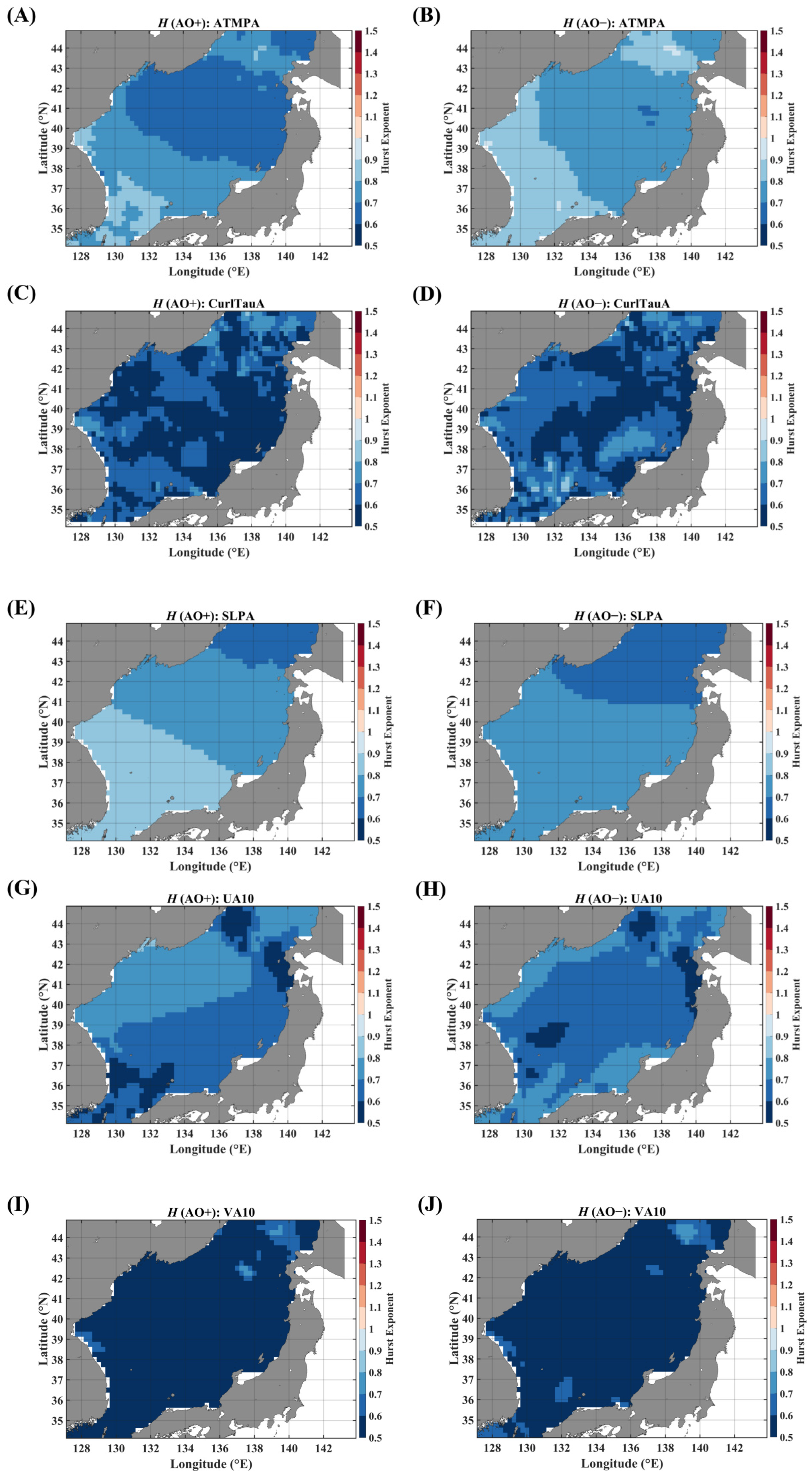
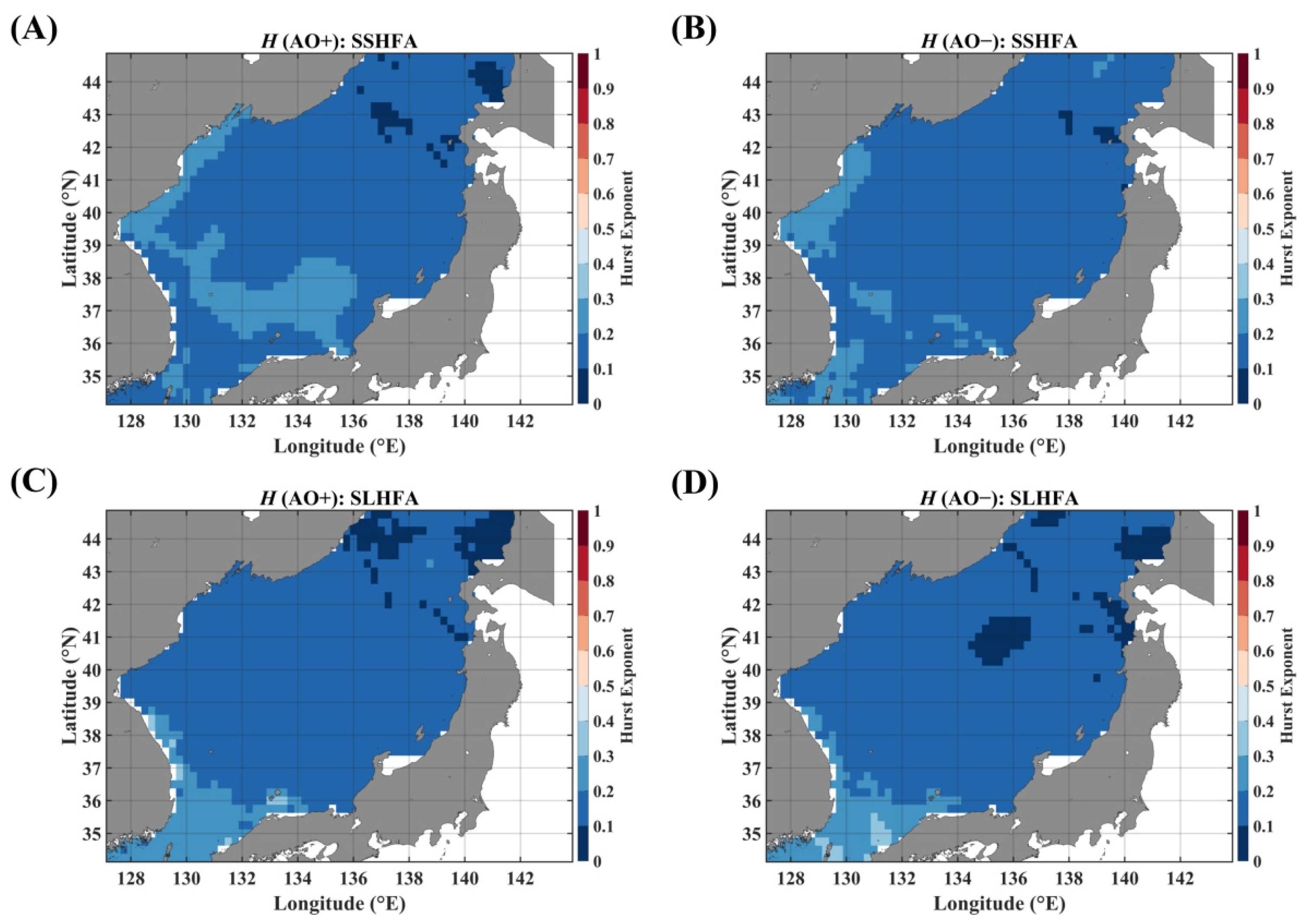
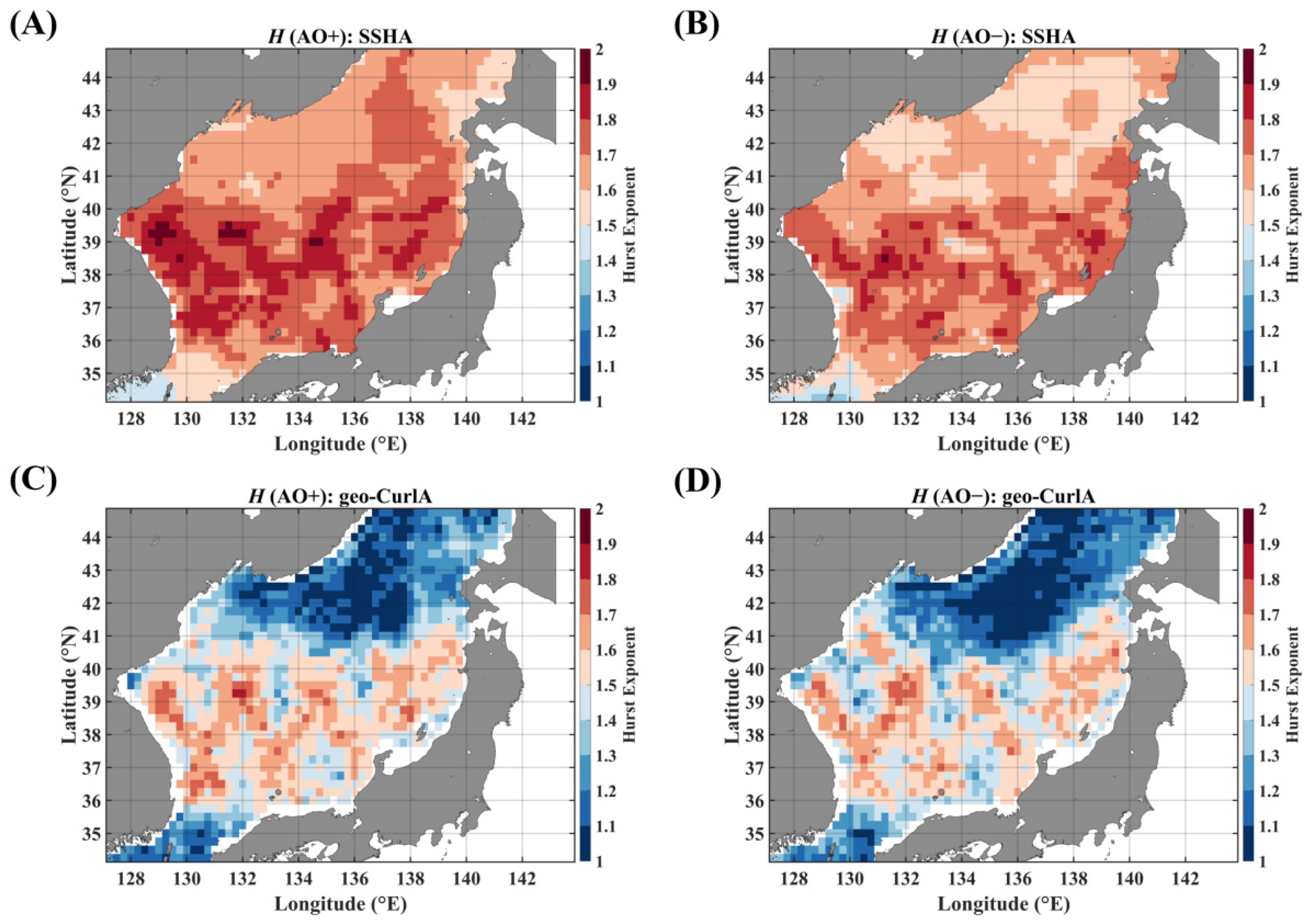
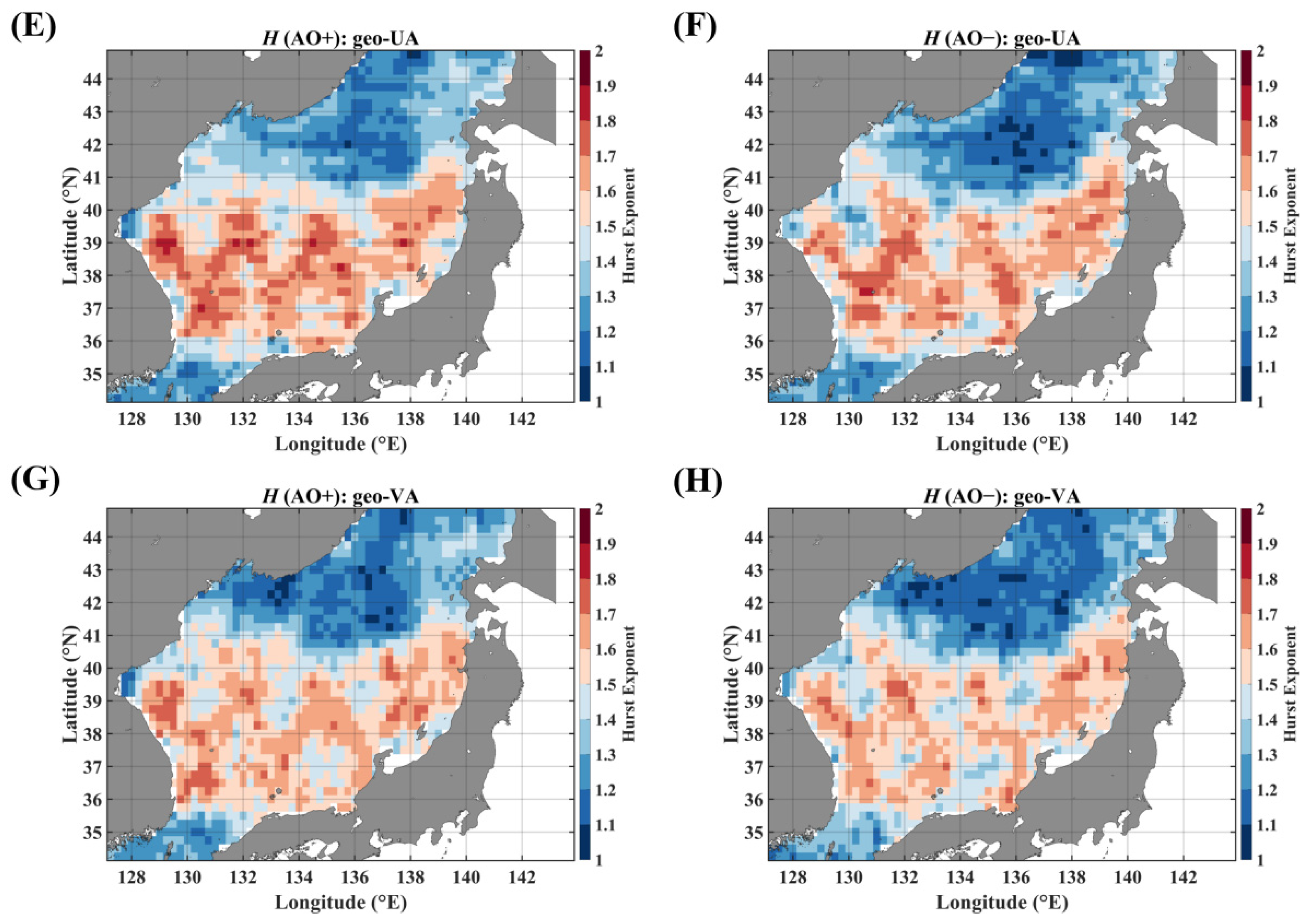
Appendix B. DCCA Algorithmic Details and Numerical Implementation
Appendix B.1. Pre-Processing and Profiles
Appendix B.2. Windowing and Segmentation
Appendix B.3. Local Detrending
Appendix B.4. Detrended Variances, Covariance, and Fluctuation Functions
Appendix B.5. DCCA Coefficient and Cross-Hurst Exponent
Appendix B.6. Numerical Notes (Implementation Mirroring the Code)
Appendix B.7. Variants and Robustness
Appendix C. DFA Algorithmic Details
References
- Gong, D.Y.; Wang, S.W.; Zhu, J.H. East Asian winter monsoon and Arctic oscillation. Geophys. Res. Lett. 2001, 28, 2073–2076. [Google Scholar] [CrossRef]
- Jeong, J.H.; Ho, C.H. Changes in occurrence of cold surges over East Asia in association with Arctic oscillation. Geophys. Res. Lett. 2005, 32, 85–93. [Google Scholar] [CrossRef]
- He, S.; Gao, Y.; Li, F.; Wang, H.; He, Y. Impact of Arctic Oscillation on the East Asian climate: A review. Earth-Sci. Rev. 2017, 164, 48–62. [Google Scholar] [CrossRef]
- Song, S.-Y.; Kim, Y.-J.; Lee, E.-J.; Yeh, S.-W.; Park, J.-H.; Park, Y.-G. Wintertime sea surface temperature variability modulated by Arctic Oscillation in the northwestern part of the East/Japan Sea and its relationship with marine heatwaves. Front. Mar. Sci. 2023, 10, 1198418. [Google Scholar] [CrossRef]
- Subrahamanyam, D.B.; Ramachandran, R.; Rani, S.I.; Kumar, B.P. Air-sea interaction processes over the east-asian marginal seas surrounding the Korean peninsula. Ann. Geophys. 2007, 25, 1477–1486. [Google Scholar] [CrossRef]
- Park, K.; Chung, J.Y. Spatial and temporal scale variations of sea surface temperature in the East Sea using NOAA/AVHRR data. J. Oceanogr. 1999, 55, 271–288. [Google Scholar] [CrossRef]
- Minobe, S.; Sako, A.; Nakamura, M. Interannual to interdecadal variability in the Japan Sea based on a new gridded upper water temperature dataset. J. Phys. Oceanogr. 2004, 34, 2382–2397. [Google Scholar] [CrossRef]
- Deser, C.; Alexander, M.A.; Xie, S.-P.; Phillips, A.S. Sea Surface Temperature Variability: Patterns and Mechanisms. Annu. Rev. Mar. Sci. 2010, 2, 115–143. [Google Scholar] [CrossRef]
- Lim, G.; Park, J.-J. Exploring Long-Term Persistence in Sea Surface Temperature and Ocean Parameters via Detrended Cross-Correlation Approach. Remote Sens. 2024, 16, 2501. [Google Scholar] [CrossRef]
- Kim, E.-J.; Hong, S.-Y. Impact of air-sea interaction on East Asian summer monsoon climate in WRF. J. Geophys. Res. 2010, 115, D19118. [Google Scholar] [CrossRef]
- Peng, C.-K.; Buldyrev, S.V.; Havlin, S.; Simons, M.; Stanley, H.E.; Goldberger, A.L. Mosaic organization of DNA nucleotides. Phys. Rev. E 1994, 49, 1685–1689. [Google Scholar] [CrossRef]
- Podobnik, B.; Stanley, H.E. Detrended Cross-Correlation Analysis: A New Method for Analyzing Two Nonstationary TimeSeries. Phys. Rev. Lett. 2008, 100, 084102. [Google Scholar] [CrossRef]
- Lim, G.; Park, J.-J. Auto- and Cross-Correlation Multifractal Analysis of Sea Surface Temperature Variability. Fractal Fract. 2024, 8, 239. [Google Scholar] [CrossRef]
- Zebende, G. DCCA cross-correlation coefficient: Quantifying level of cross-correlation. Phys. A 2011, 390, 614–618. [Google Scholar] [CrossRef]
- Hasselmann, K. Stochastic climate models Part I. Theory. Tellus 1976, 28, 473–485. [Google Scholar] [CrossRef]
- Lim, G.; Park, J.-J. Arctic Oscillation Modulation of Winter Air–Sea Coupling in the East/Japan Sea: Persistence, Timescales, and Extremes. arXiv 2025, arXiv:2509.09628. [Google Scholar] [CrossRef]
- Schreiber, T.; Schmitz, A. Improved Surrogate Data for Nonlinearity Tests. Phys. Rev. Lett. 1996, 77, 635–638. [Google Scholar] [CrossRef]
- Podobnik, B.; Jiang, Z.-Q.; Zhou, W.-X.; Stanley, H.E. Statistical tests for power-law cross-correlated processes. Phys. Rev. E 2011, 84, 066118. [Google Scholar] [CrossRef] [PubMed]
- Benjamini, Y.; Hochberg, Y. Controlling the false discovery rate: A practical and powerful approach to multiple testing. J. R. Stat. Soc. B 1995, 57, 289–300. [Google Scholar] [CrossRef]
- Huang, B.; Liu, C.; Freeman, E.; Graham, G.; Smith, T.; Zhang, H.-M. Assessment and intercomparison of NOAA daily optimum interpolation sea surface temperature (DOISST) version 2.1. J. Clim. 2021, 34, 7421–7441. [Google Scholar] [CrossRef]
- Reynolds, R.W.; Smith, T.M.; Liu, C.; Chelton, D.B.; Casey, K.S.; Schlax, M.G. Daily high-resolution-blended analyses for sea surface temperature. J. Clim. 2007, 20, 5473–5496. [Google Scholar] [CrossRef]
- Hersbach, H.; Bell, B.; Berrisford, P.; Hirahara, S.; Horányi, A.; Muñoz-Sabater, J.; Nicolas, J.; Peubey, C.; Radu, R.; Schepers, D.; et al. The ERA5 global reanalysis. Q. J. R. Meteorol. Soc. 2020, 146, 1999–2049. [Google Scholar] [CrossRef]
- Pujol, M.-I.; Faugère, Y.; Taburet, G.; Dupuy, S.; Pelloquin, C.; Ablain, M.; Picot, N. DUACS DT2014: The new multi-mission altimeter data set reprocessed over 20 years. Ocean Sci. 2016, 12, 1067–1090. [Google Scholar] [CrossRef]
- Taburet, G.; Sanchez-Roman, A.; Ballarotta, M.; Pujol, M.-I.; Legeais, J.-F.; Fournier, F.; Faugere, Y.; Dibarboure, G. DUACS DT2018: 25 years of reprocessed sea level altimetry products. Ocean Sci. 2019, 15, 1207–1224. [Google Scholar] [CrossRef]
- NOAA CPC. Arctic Oscillation (AO) Index. National Oceanic and Atmospheric Administration Climate Prediction Center. 2023. Available online: https://www.cpc.ncep.noaa.gov/products/precip/CWlink/daily_ao_index/ao.shtml (accessed on 10 April 2024).
- Thompson, D.W.; Wallace, J.M. Annular modes in the extratropical circulation. Part I: Month-to-month variability. J. Climate 2000, 13, 1000–1016. [Google Scholar] [CrossRef]
- Kantelhardt, J.W.; Zschiegner, S.A.; Bunde, E.K.; Havlin, S.; Bunde, A.; Stanley, H.E. Multifractal detrended fluctuation analysis of nonstationary time series. Phys. A 2002, 316, 87–114. [Google Scholar] [CrossRef]
- Frankignoul, C.; Hasselmann, K. Stochastic climate models, part ii application to sea-surface temperature anomalies and thermocline variability. Tellus 1997, 29, 289–305. [Google Scholar] [CrossRef]
- Podobnik, B.; Horvatic, D.; Ilic, S.; Stanley, H.E. Detrended cross-correlation analysis for non-stationary time series with periodic trends. Eur. Phys. J. B 2011, 84, 445–449. [Google Scholar]
- Lim, G.; Min, S. Effect of Outliers and Non-consecutive Data Points on the Detrended Cross-Correlation Analysis. J. Korean Phys. Soc. 2018, 72, 545–550. [Google Scholar] [CrossRef]
- Mandelbrot, B.B.; Van Ness, J.W. Fractional Brownian motions, fractional noises and applications. SIAM Rev. 1968, 10, 422–437. [Google Scholar] [CrossRef]
- Voss, R.F. Random Fractal Forgeries. In Fundamental Algorithms in Computer Graphics; Earnshaw, R.A., Ed.; Springer: Berlin/Heidelberg, Germany, 1985; pp. 805–835. [Google Scholar]
- Feder, J. Fractals; Plenum Press: New York, NY, USA, 1988; ISBN 978-0306428519. [Google Scholar]
- Zhou, W.-X. Multifractal detrended cross-correlation analysis for two nonstationary signals. Phys. Rev. E 2008, 77, 066211. [Google Scholar] [CrossRef]
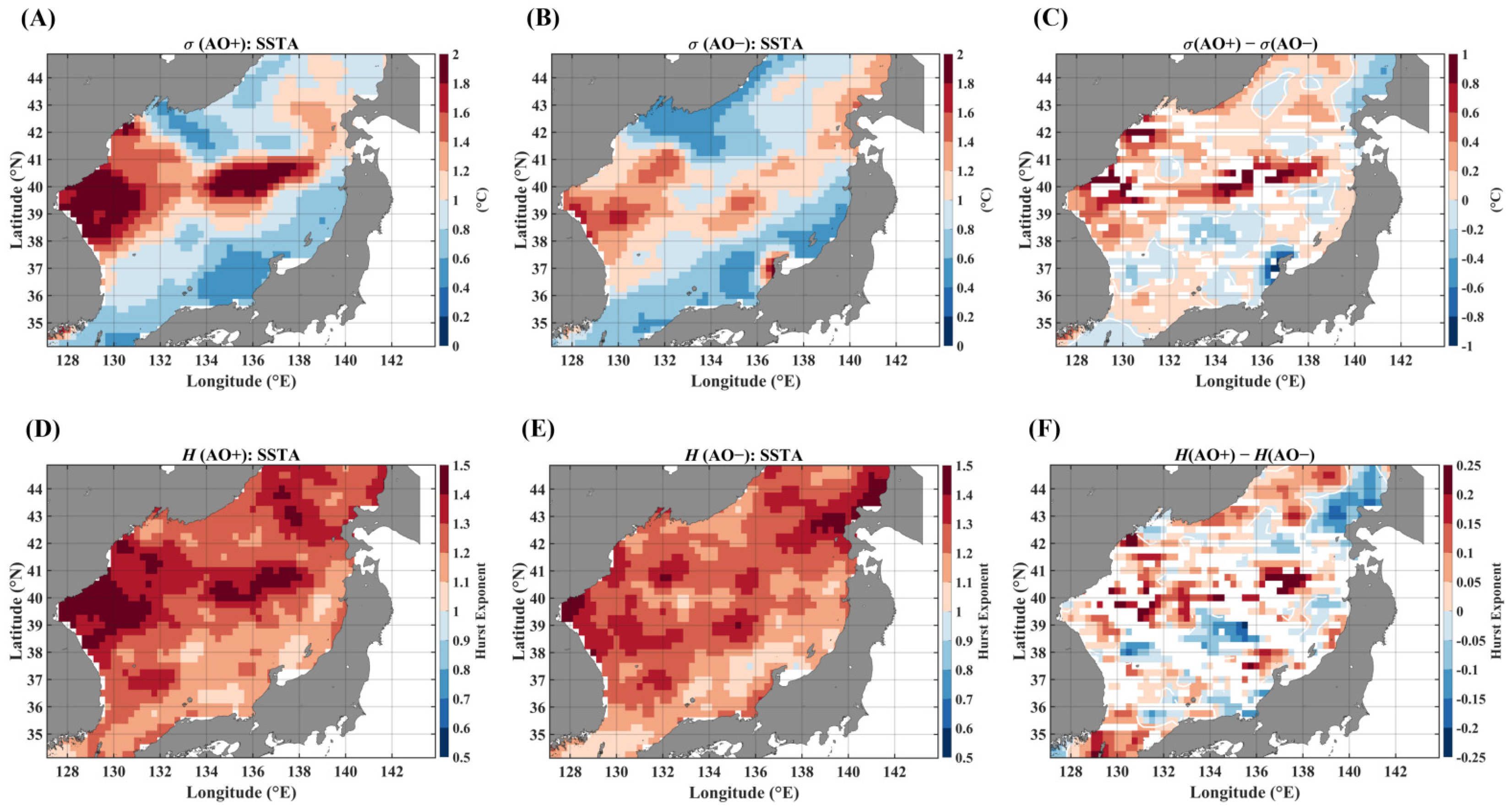

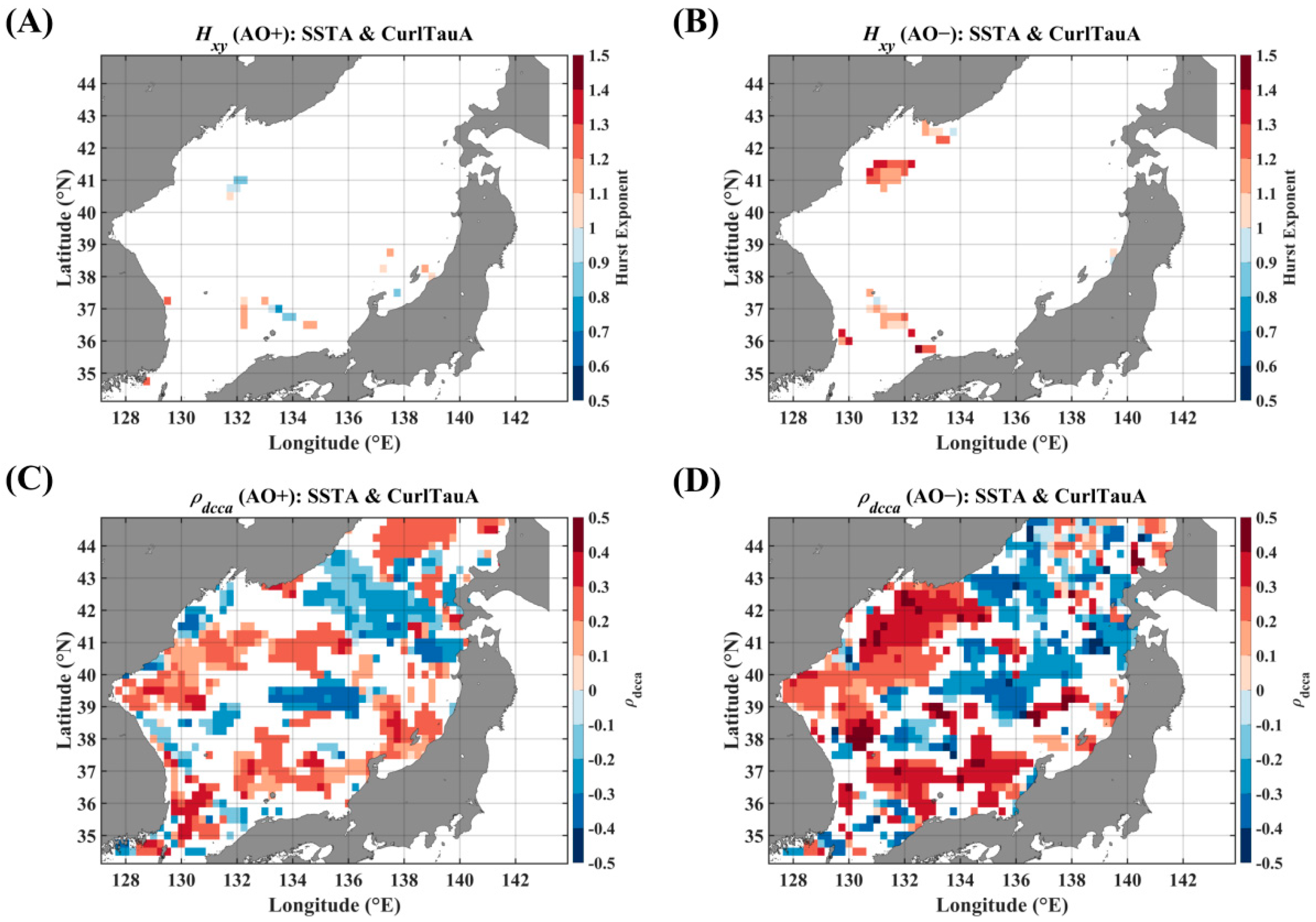
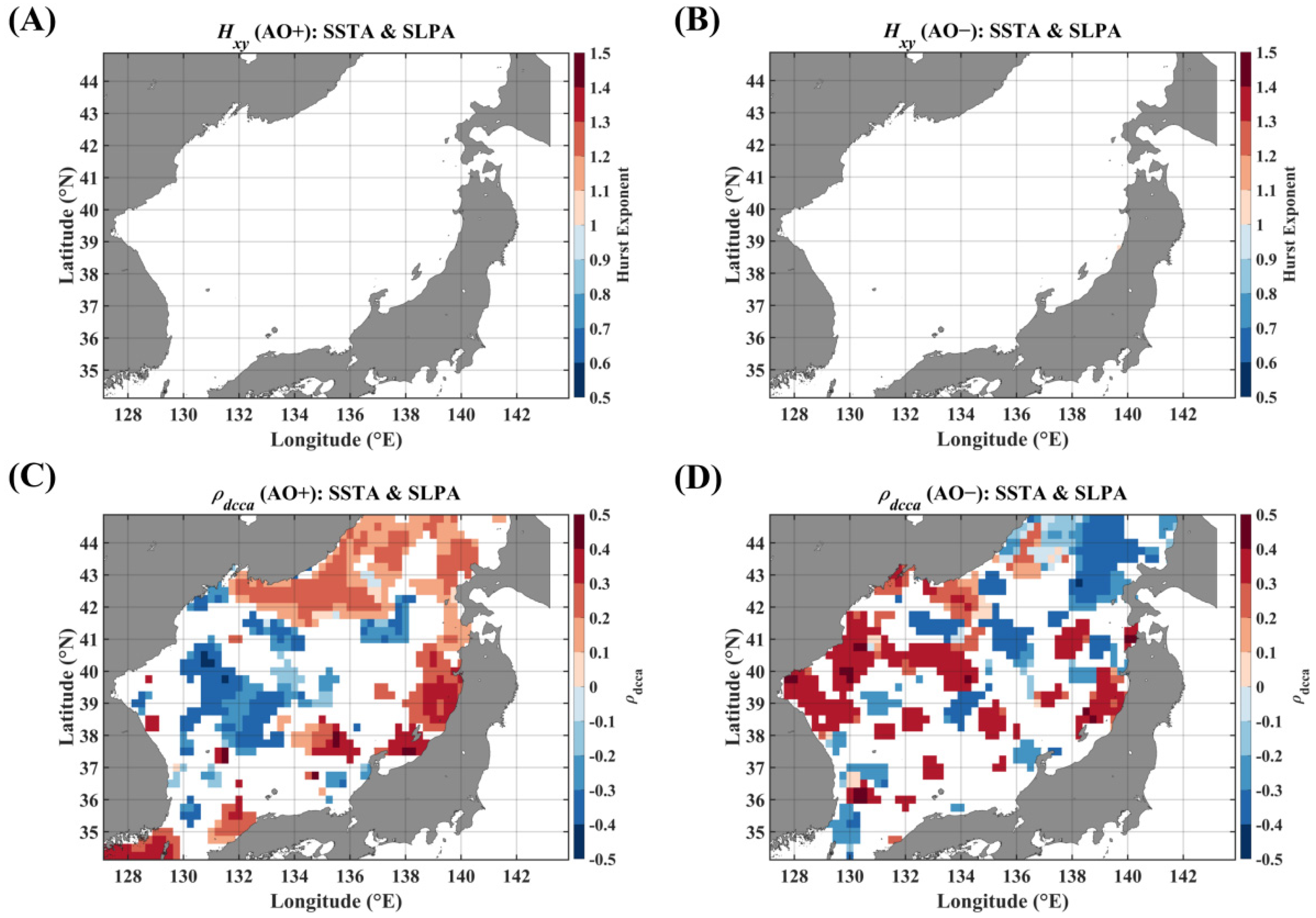




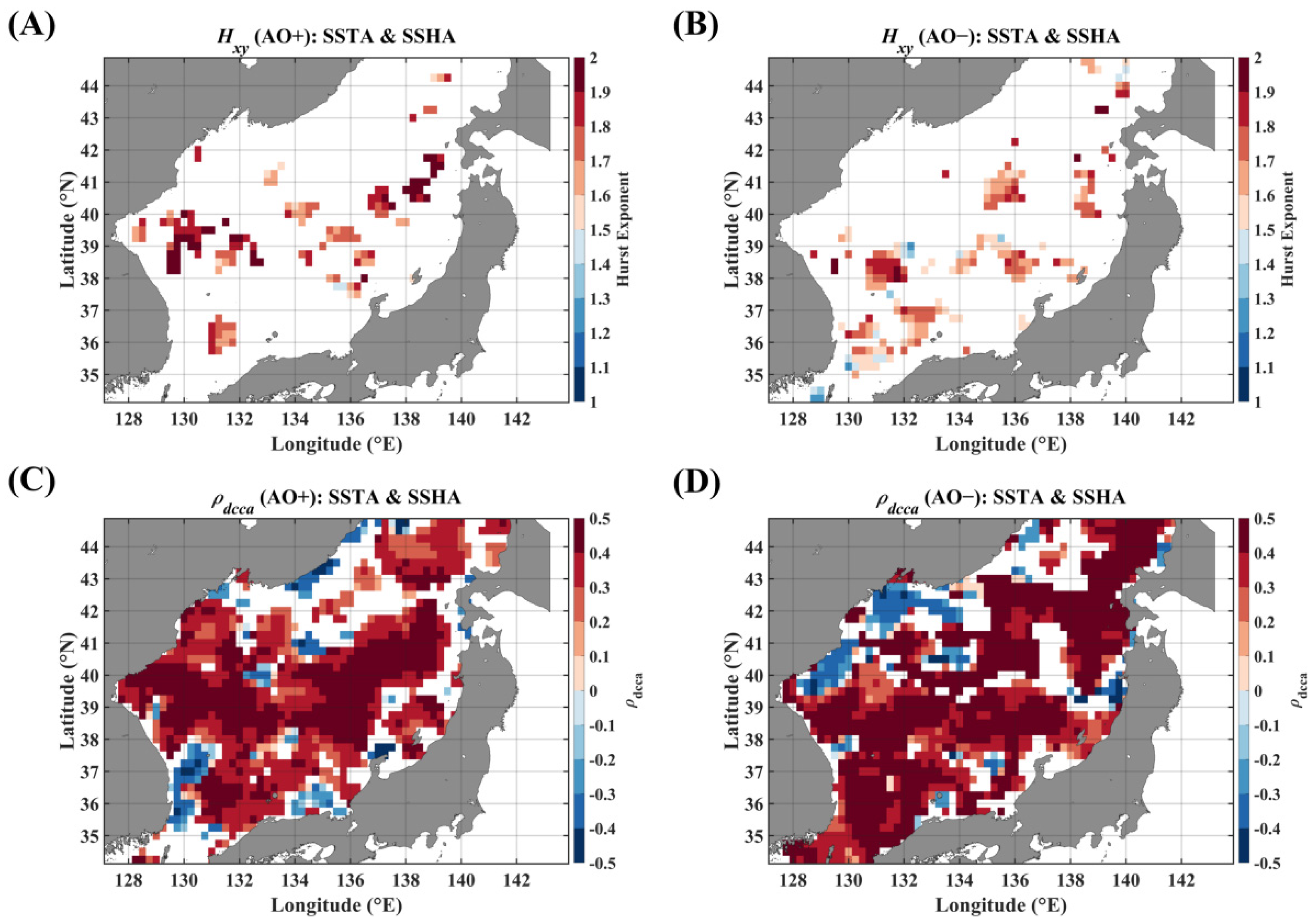


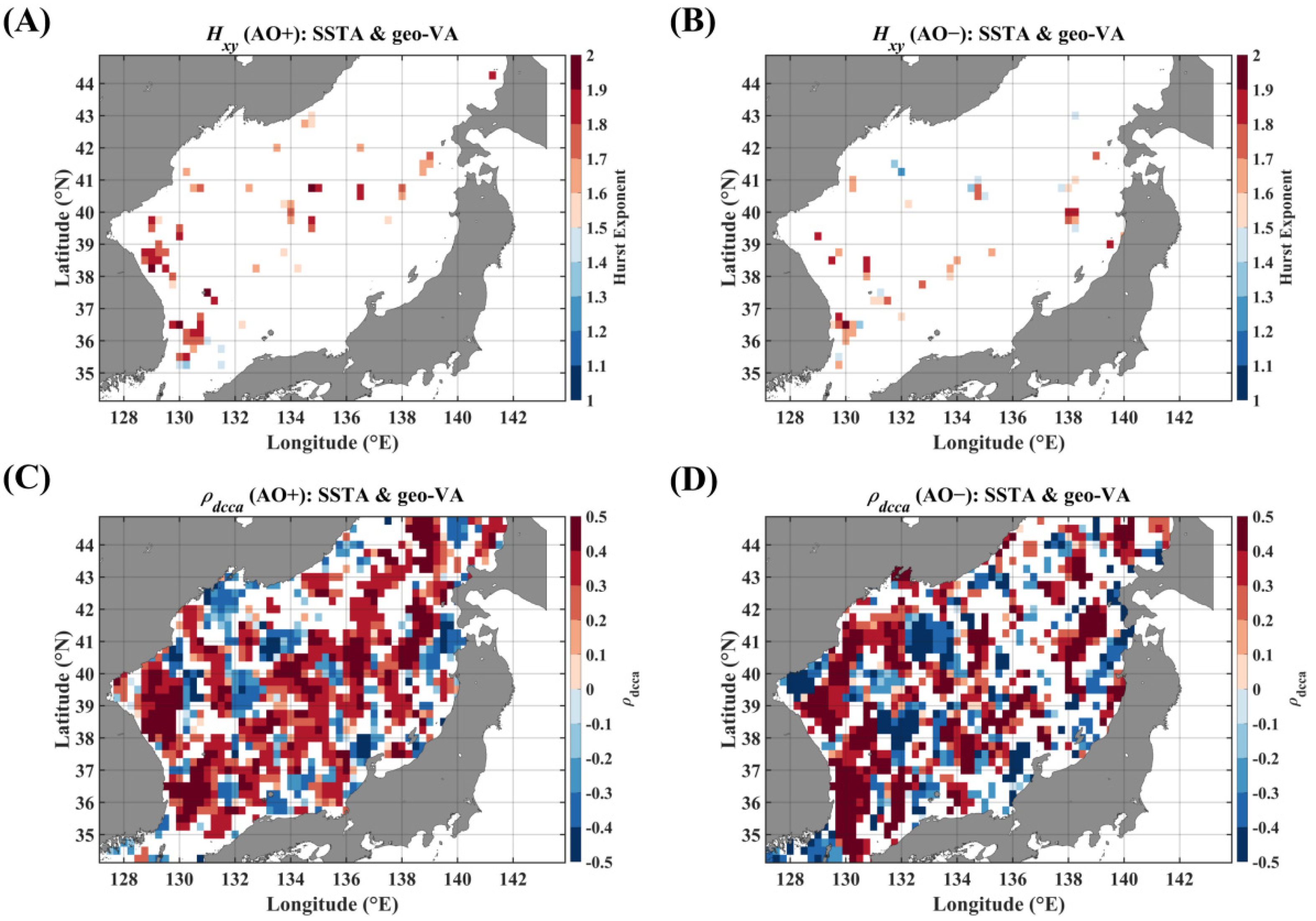
Disclaimer/Publisher’s Note: The statements, opinions and data contained in all publications are solely those of the individual author(s) and contributor(s) and not of MDPI and/or the editor(s). MDPI and/or the editor(s) disclaim responsibility for any injury to people or property resulting from any ideas, methods, instructions or products referred to in the content. |
© 2025 by the authors. Licensee MDPI, Basel, Switzerland. This article is an open access article distributed under the terms and conditions of the Creative Commons Attribution (CC BY) license (https://creativecommons.org/licenses/by/4.0/).
Share and Cite
Lim, G.; Park, J.-J. Wintertime Cross-Correlational Structures Between Sea Surface Temperature Anomaly and Atmospheric-and-Oceanic Fields in the East/Japan Sea Under Arctic Oscillation. Fractal Fract. 2025, 9, 684. https://doi.org/10.3390/fractalfract9110684
Lim G, Park J-J. Wintertime Cross-Correlational Structures Between Sea Surface Temperature Anomaly and Atmospheric-and-Oceanic Fields in the East/Japan Sea Under Arctic Oscillation. Fractal and Fractional. 2025; 9(11):684. https://doi.org/10.3390/fractalfract9110684
Chicago/Turabian StyleLim, Gyuchang, and Jong-Jin Park. 2025. "Wintertime Cross-Correlational Structures Between Sea Surface Temperature Anomaly and Atmospheric-and-Oceanic Fields in the East/Japan Sea Under Arctic Oscillation" Fractal and Fractional 9, no. 11: 684. https://doi.org/10.3390/fractalfract9110684
APA StyleLim, G., & Park, J.-J. (2025). Wintertime Cross-Correlational Structures Between Sea Surface Temperature Anomaly and Atmospheric-and-Oceanic Fields in the East/Japan Sea Under Arctic Oscillation. Fractal and Fractional, 9(11), 684. https://doi.org/10.3390/fractalfract9110684





